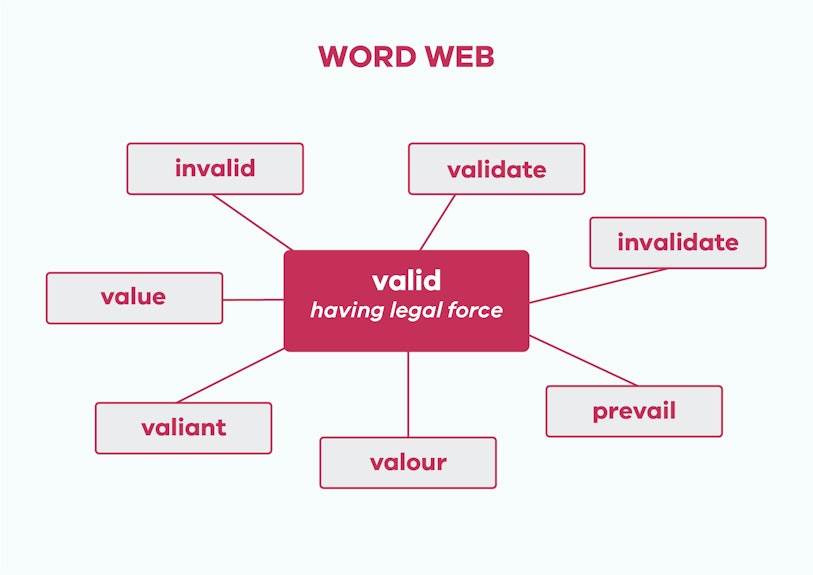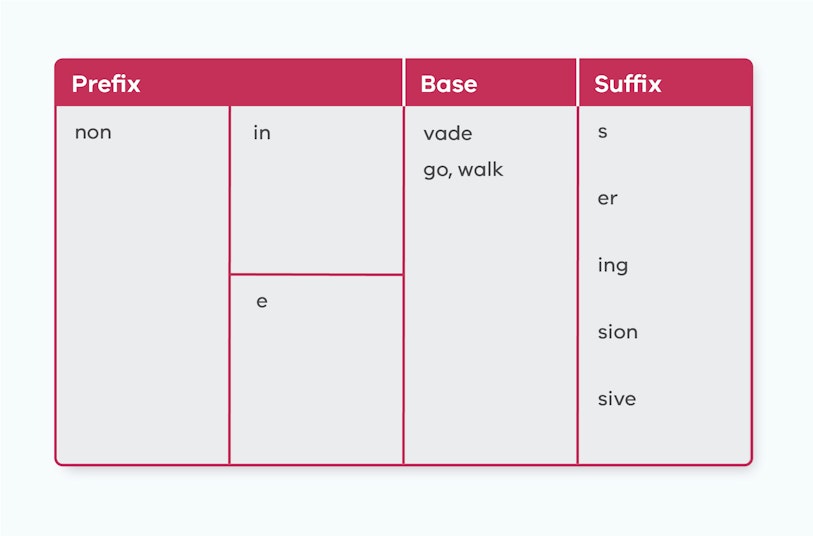Suggested Learning Intentions
- To explore the meaning and origins of unfamiliar words
- To deepen understanding of word meaning to improve reading comprehension
Sample Success Criteria
- I can research and explain the origins of a word to discover its meaning
- I can break words into meaningful parts (morphemes) to predict word meaning and support correct spelling
Pose the question, ‘What do we do when we encounter unfamiliar vocabulary?’
Listen to student responses and record their ideas on the board.
Ask: What might valid mean in this sentence?
‘Lex has a valid excuse for not attending school on Friday.’
- a weak excuse
- a truthful excuse
- a believable excuse
- an amusing excuse.
Enable students to recognise valid as an adjective by discussing the sentence and modelling how to identify the grammatical functions of key words and phrases.
Ask students to discuss their thinking. Demonstrate how to use a dictionary or etymolonline to examine the meaning of the word ‘valid’. Explain that the etymological root of the word is from Latin and means, having legal force, and to be strong and/or effective.
Develop a word web with students, using the word ‘valid’ as a base. Related words could include invalid, validity, validate, valour, valiant, prevail, value.

Model how to create an interactive word web using Visuwords and discuss the word web with students. Question prompts include:
- What might be the common root shared by these words?
- What are some of the prefixes and suffixes that have been added to the base word?
- How have the prefixes and suffixes changed the word’s meaning and function?
Explain to students that there are levels or degrees at which we can ‘know a word’:
- We fully understand what a word means. We could explain what it means and use it effectively.
- We have a vague or unclear understanding of a word. We may have heard it before and have a vague sense of what the word relates to.
- We may have seen or heard the word, but do not know the meaning or how to use the word,
- We have never seen or heard the word before.
Distribute cut up copies of the word/definition matching activity available from the Materials and texts section above.
Ask students to rate how well they know each word by the levels outlined above and to work in pairs to match the words with the provided definitions. Encourage students to think of related words and to attempt to use the word in conversation. Invite students to check their predictions by referring to dictionaries.
Provide students with a short sentence or text extract that includes complex or unfamiliar vocabulary and ideas or events. For example:
- As early as the second century, there was talk of terra australis incognita, a hypothetical southern continent. After Dutch explorers landed on our shores, Australia was briefly referred to as New Holland. In 1770 Captain James Cook landed in Botany Bay, home of the Eora people. Cook claimed possession of the East Coast of Australia for Britain, incorrectly applying the legal doctrine of ‘terra nullius’. Cook named the lands he encountered New South Wales. It was Matthew Flinders who first used the current name, Australia, after circumnavigating the continent and mapping the coastline in 1803.
Invite students to speculate on the gist of this passage, to suggest a heading and to restate it in their own words. Ask them to underline any unfamiliar words. Distribute the table, How well do I understand this word? (available in the Materials and texts section above) and support students to enter and rate their understanding of challenging vocabulary in the table.
Organise students to work in pairs to conduct an etymological analysis of selected words from the Etymological analysis resource available in the Materials and texts section above. It may be useful to spend time explaining that an etymological analysis is used to unravel the historical threads of a word to discover its original meaning.
Encourage students to list related words, for example, terra is the Latin for 'earth'. This knowledge builds understanding of terms such as terrain, territory, subterranean and terrestrial.
Refer to possible teaching points on the terms australis, incognita, hypothetical, continent, Dutch explorers, New Holland, Eora, terra nullius, circumnavigate, and Mathew Flinders.
Ask students to rewrite and expand the original passage in their own words when they have completed the etymological investigation.
Provide opportunities for students to explore word etymology and meaning from authentic texts. For example, the Behind the News episode ‘The story all starts with this – a microscopic bacteria’, includes concepts and vocabulary that could be examined to deepen understanding of the text and to develop vocabulary knowledge. A transcript of the program could be used in close reading groups to explore tier one words such as antibiotic, bacteria, microscopic, pharmacy and virus; tier two words such as infection, mould, elite, invade, multiply and prescribe, and the idiomatic phrase, ‘turn the tide’.
Students summarise the text using the Non-fiction Summary handout available in the Materials and texts section above.
Display a list of new vocabulary from the focus text. Invite students to explain the meaning of words and to use them in a sentence. Ask students what strategies might support the accurate spelling of the focus words. Students may suggest breaking words into syllables and applying their phonological knowledge. While these are useful strategies, using morphemic and etymological knowledge provides students with more strategies with which to spell and interpret a word.
Demonstrate a word analysis using morphology, etymology and phonology. For example:
- Write the word ‘invade’ on the board and provide a student friendly definition, for example, to enter a place and take control.
- Write the etymological parts of the word on the board; in + vade (go, walk)
- Invite students to use the word in a sentence and to suggest what types of texts might include this word.
Ask students to add prefixes or suffixes to invade; invader, invasion, invasive, non-invasive.
Record the words on a word matrix. Consider using an online matrix-maker and modelling ‘word sums’. For example, the word sums in the word matrix below would include:
- in + vade
- e + vade
- in + vade + s
- in + vade + ion
- non + in + vade + ive

Discuss how the suffix changes the function of the word; for example, invade is a verb, invader and invasion are nouns, invasive and non-invasive are adjectives.
Discuss the changes to the base ‘vade’ when adding suffixes.
Ask students to predict what ‘evade’ might mean?
Enable students to understand how prefixes and suffixes change word meaning and function by using familiar vocabulary. For example, using help, hope, joy or please or as a base.
Extend student understanding of word building by asking them to write the word sums in the matrix above and/or to create a word matrix for bases such as scribe, sign, struct, script.
Invite students to share and discuss the reading summaries.
Facilitate a discussion on why it is important to understand the key vocabulary in a text and the strategies that readers can use to predict and confirm word meaning. Remind students of strategies readers use when they encounter an unknown word.
Ask students to work in small groups to brainstorm words that share a common base. For example, bio (life), auto (self) multi (many), metre (measure). Display and discuss the vocabulary with the students.
Provide guiding question prompts such as:
- If ‘bio’ means ‘life’, what might these words mean: probiotic, antibiotic, biodiversity, biohazard?
- If ‘multi’ means ‘many or many times’, what might these words mean: multicultural, multifaceted, multimedia, multidimensional?
Ask students to select and define three words on an exit ticket. Challenge them to also use each word in a sentence or short passage.
Enable students to define words by demonstrating strategies to identify the morphemic components of the word, for example, bio (life) + hazard (danger). Discuss where we might see the word and the symbol it represents. Suggest that it is a noun that refers to a material that is dangerous to life. Provide a sentence using the word; ‘The poisonous chemical detected in the creek was a biohazard, a danger to humans and animals.’
Extend students with the following prompt: If ‘dermat’ means skin and ‘ist’ is a word forming element that means ‘one who does or makes’, what is meant by the word dermatologist? What might be the words ‘dermatitis’ and dermatology mean?
Assessment opportunities in this stage are provided by the writing task, the reading summary sheet, word matrix and the exit ticket vocabulary task. Anecdotal observations could be made while students are working on the word/definition matching activity, in reading groups and during group discussions.
ABC: Behind the News, 2013. Antibiotics. [Online]
Available at: https://www.abc.net.au/btn/classroom/antibiotics/10530924
[Accessed 15 March 2022].
Dillon, M. & Dempster, A., 2019. The intrepid spirit of Matthew Flinders lives on in more than 100 Australian sites. [Online]
Available at: https://www.abc.net.au/news/2019-01-26/the-spirit-of-matthew-flinders-lives-on-throughout-australia/10749314
[Accessed 15 March 2022].
Harper, D., 2020. Etymonline: Online etymology dictionary. [Online]
Available at: https://www.etymonline.com/
[Accessed 15 March 2022].
Ramsden, N., 2012. Mini matrix-maker. [Online]
Available at: http://www.neilramsden.co.uk/spelling/matrix/temp/index.html
[Accessed 15 March 2022].
State Library of N.S.W, n.d. Eora: 1170 - 1850: Mapping Aboriginal Sydney. [Online]
Available at: https://www.sl.nsw.gov.au/stories/eora
[Accessed 15 March 2022].
Visuwords, n.d. Visuwords: valid. [Online]
Available at: https://visuwords.com/valid
[Accessed 15 March 2022].
Other stages
1. The History of the English Language
EXPLORESuggested Learning Intentions
- To develop curiosity and knowledge about how the English language has evolved
- To understand that some English vocabulary comes from words in other languages
Sample Success Criteria
- I can investigate and explain the meaning of words derived from other languages
- I can explain how the meaning of words have changed over time
3. Developing Word Knowledge: Exploring Affixes and Bases
EXPLORESuggested Learning Intentions
- To learn the meaning of some common Latin and Greek root words
- To understand how affixes change the meaning and function of words
Sample Success Criteria
- I can use affixes to build a word family
- I can make a link between root words and the meaning of a derived word
4. The Family Tree of Australian English
EXPLORESuggested Learning Intentions
- To explore the evolving inter-relationship between Australian Aboriginal languages and Australian English
Sample Success Criteria
- I can explain how some Aboriginal words have been borrowed and used in Australian English
- I can explain how English words are used in Aboriginal English
- I can explain the history and meaning of some Australian place names
5. Australian English: Formal and Informal Language
EXPLORESuggested Learning Intentions
- To understand the difference between formal and informal language
Sample Success Criteria
- I can identify formal and informal language
- I can explain when to use formal and informal language
- I can explain the meaning of some Aboriginal words